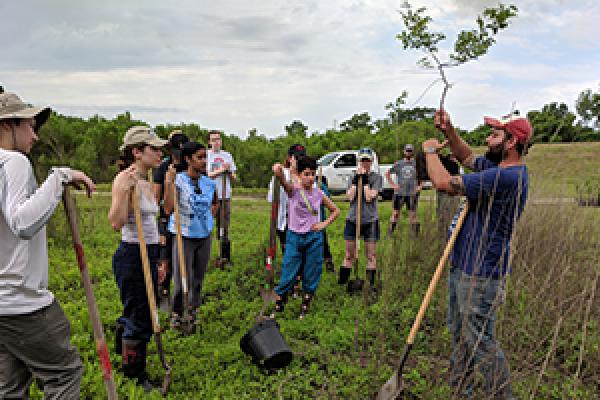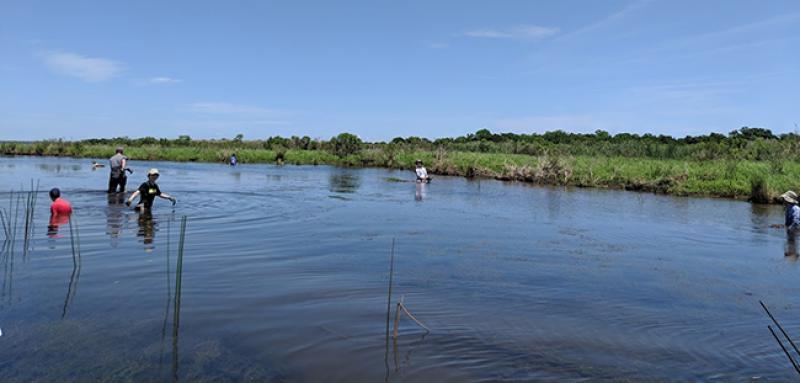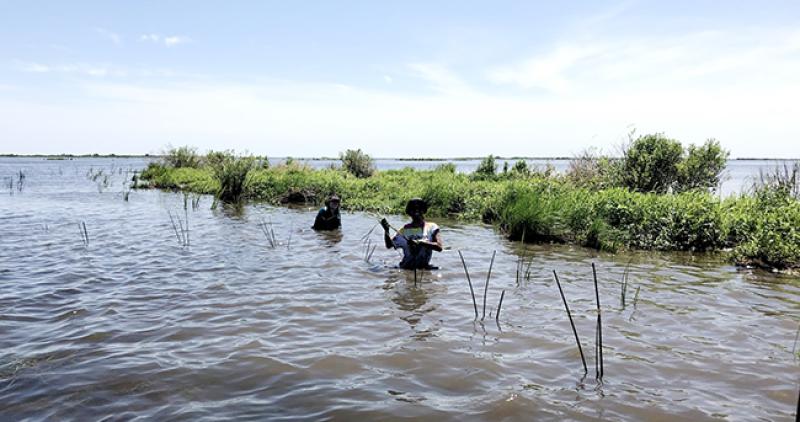Climate change, humanities converge in Louisiana field school

As Thomas Davis and his students gazed across the murky swamps of southern Louisiana, the striking connection between the region’s environmental injustices and their causes became tragically evident.
“You have these white, hulking chunks of dead cypress trees everywhere, and then over in the distance you see a massive petrochemical refinery,” Davis said. “These juxtapositions are so naked down there — it’s so apparent wherever you go.”
Davis, an associate professor of English, recently led the Livable Futures Louisiana Field School, where he and associate professor of women’s, gender and sexuality studies Mary Thomas guided nine students through post-Hurricane Katrina Louisiana. From May 5-11, the group explored the state’s southeastern coastline, replanted vegetation throughout the marshes to help resuscitate damaged ecosystems, workshopped with local environmental artist Hannah Chalew and toured the bayou with a New Orleans-based filmmaker and documentarian.
The trip was an opportunity for the students to see environmental justice firsthand and to connect with those impacted by it the most.
“In a place like Louisiana, all of these questions around climate change, land loss, fossil fuels and social justice feel very urgent and interconnected,” Davis said. “The hope is that this course helps students think about the climate crisis and various environmental problems as something that’s not far away; we have to think now in innovative ways and respond with the urgency the crisis deserves.”
Livable Futures began in fall 2018, and its beginnings take root in the Global Arts + Humanities Discovery Theme (GAHDT). In 2016, Davis, Thomas and associate professor of history Christopher Otter collaborated on a two-year pilot project for GAHDT that brought together disciplines in the arts and humanities to shed light on topics surrounding environmental justice and advocacy.
The success of the pilot project gave way to Livable Futures, a collaborative network of arts and humanities faculty who draw on their collective expertise to change cultural thinking surrounding climate change and planetary sustainability.
“The sciences aren’t going to solve climate change alone,” Davis said. “We have mountains of data and information, and still carbon emissions climb higher and the U.S. continues to engage in intensive fossil fuel extraction. The climate crisis is a social and cultural problem as well. So how do we begin to understand those dimensions? The humanities have specific kinds of expertise and knowledge, and we are very well-positioned to contribute to and maybe change the way we think about environmental crises.”

Photo credit Mary Thomas.

Ohio State students plant vegetation throughout Louisiana coast. Photo credit Riley Sayers.
During the Louisiana field school, students observed these environmental crises and got involved with the ways in which they are being confronted. Davis got in touch with the Common Ground Collective, a network of nonprofits born in the wake of Hurricane Katrina that continues rehabilitation work around the New Orleans area. Students stayed in the organization’s bunkhouses in New Orleans’ Lower Ninth Ward, one of the region’s hardest hit neighborhoods.
Throughout the field school, the group:
- Visited different ecologically sensitive sites to learn about conservation and sustainability
- Saw the devastating consequences manmade canals had on local vegetation
- Planted saplings in flood zones to help slow future floodwaters and mitigate erosion
- Met with local filmmaker Monique Verdin, who revealed the harm the oil and gas industry had on the ecosystem.
“You can see the infrastructure of environmental damage in places like Cancer Alley,” Davis said. “And on the other hand, you see the ways people respond — from rebuilding wetlands to doing these different art practices that try to change cultural and political consciousness.”
Though Davis isn’t sure the field school will be reproduced in the same way next spring, he plans to continue developing connections between Livable Futures and southern Louisiana.
“I have collaborators down there we didn’t get to do anything with,” he said. “Ideally, I think we would like to build and sustain our relationships with artists, activists, and researchers in southern Louisiana over the coming years.”
